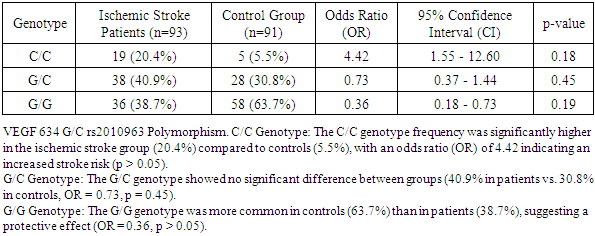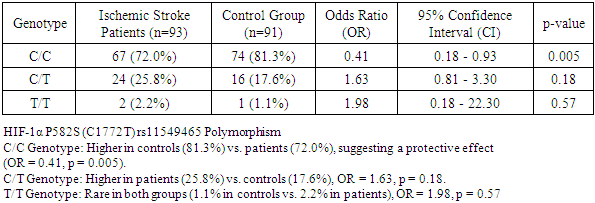-
Paper Information
- Paper Submission
-
Journal Information
- About This Journal
- Editorial Board
- Current Issue
- Archive
- Author Guidelines
- Contact Us
American Journal of Medicine and Medical Sciences
p-ISSN: 2165-901X e-ISSN: 2165-9036
2024; 14(9): 2307-2310
doi:10.5923/j.ajmms.20241409.39
Received: Jul. 30, 2024; Accepted: Aug. 28, 2024; Published: Sep. 21, 2024

Molecular Markers in Ischemic Stroke: Genetic Polymorphisms and Risk Assessment
Vokhidova Dildora Alikulovna 1, Usmanova Durdona Djurabaevna 1, Khodjimetov Dilshod Nayimovich 2, Vokhidov Alikul Meltoshevich 3
1Tashkent Pediatric Medical Institute, Uzbekistan
2Republican Specialized Scientific and Practical Medical Center of Neurosurgery, Uzbekistan
3Samarkand State Medical Institute, Uzbekistan
Correspondence to: Khodjimetov Dilshod Nayimovich , Republican Specialized Scientific and Practical Medical Center of Neurosurgery, Uzbekistan.
| Email: |  |
Copyright © 2024 The Author(s). Published by Scientific & Academic Publishing.
This work is licensed under the Creative Commons Attribution International License (CC BY).
http://creativecommons.org/licenses/by/4.0/

This study investigates the genetic predictors of ischemic stroke by analyzing the frequency of single nucleotide polymorphisms (SNPs) in candidate genes. Conducted from 2020 to 2022 at the Republican Scientific Center for Emergency Medical Care, the research involved 93 patients with ischemic stroke (46 with primary stroke and 47 with recurrent stroke) and 91 healthy controls. Genetic analyses focused on VEGF and HIF-1α genes. Results indicate significant associations between specific genotypes and ischemic stroke risk, suggesting potential genetic markers for stroke predisposition.
Keywords: Ischemic Stroke, Genetic Predisposition, Single Nucleotide Polymorphism, VEGF, HIF-1α
Cite this paper: Vokhidova Dildora Alikulovna , Usmanova Durdona Djurabaevna , Khodjimetov Dilshod Nayimovich , Vokhidov Alikul Meltoshevich , Molecular Markers in Ischemic Stroke: Genetic Polymorphisms and Risk Assessment, American Journal of Medicine and Medical Sciences, Vol. 14 No. 9, 2024, pp. 2307-2310. doi: 10.5923/j.ajmms.20241409.39.
1. Introduction
- Ischemic stroke is a leading cause of disability and death worldwide, posing significant challenges to healthcare systems due to its complex etiology and varied clinical presentations. Understanding the genetic underpinnings of ischemic stroke is crucial for developing targeted preventive and therapeutic strategies. Recent advances in molecular genetics have identified various genetic markers associated with increased risk of ischemic stroke, providing new insights into its pathogenesis.Genetic polymorphisms, particularly single nucleotide polymorphisms (SNPs), have been implicated in the development of ischemic stroke. These genetic variations can influence the expression and function of proteins involved in critical biological pathways such as angiogenesis, vascular integrity, and hypoxia response. Specifically, genes such as VEGF (vascular endothelial growth factor) and HIF-1α (hypoxia-inducible factor 1-alpha) have garnered attention due to their roles in vascular health and response to ischemic conditions.Several studies have explored the relationship between genetic polymorphisms and ischemic stroke. For instance, a study by Hăşmăşanu et al. (2023) examined the association between the VEGF gene polymorphism and ischemic stroke, finding significant links between certain SNPs and increased stroke risk [3]. Another study by Vokhidova et al. (2020) identified polymorphisms in the HIF-1α gene as potential risk factors for ischemic stroke, highlighting the gene's role in hypoxia response and vascular adaptation [10]. Additionally, a meta-analysis by Lindgren et al. (2014) reviewed multiple studies on genetic variations in stroke-related genes, confirming the importance of genetic predisposition in ischemic stroke susceptibility [4]. These findings underscore the relevance of genetic research in understanding and managing ischemic stroke.The primary motivation for this study is to elucidate the genetic predictors of ischemic stroke by analyzing the frequency of SNPs in candidate genes among patients with primary and recurrent ischemic stroke. Identifying these genetic markers can enhance our understanding of stroke pathophysiology, potentially leading to improved risk assessment and personalized treatment approaches.The aims of this study are threefold: first, to determine the association between specific SNPs in VEGF and HIF-1α genes and the risk of ischemic stroke; second, to compare the frequency of these SNPs between patients with primary and recurrent ischemic stroke; and third, to assess the potential protective or risk-modifying effects of these genetic variations.
2. Mаteriаls аnd Methоds
- The study involved molecular-genetic analyses conducted in a specialized laboratory at the Republican Scientific Center of Hematology. We analyzed the following polymorphic sites: VEGF 634 G/C rs2010963, VEGF 2578C/A, and HIF-1α P582S (C1772T) rs11549465. The study included 93 patients with ischemic stroke, divided into primary stroke (46 patients) and recurrent stroke (47 patients) subgroups, along with 91 healthy controls. Blood samples were collected and analyzed for SNP frequencies. Genetic analyses were performed using PCR and sequencing technologies to identify SNPs in the targeted genes.DNA Extraction and Genotyping. Peripheral blood samples were collected from all participants. Genomic DNA was extracted using the QIAamp DNA Blood Mini Kit (Qiagen, Germany) according to the manufacturer’s instructions. The concentration and purity of the extracted DNA were measured using a NanoDrop spectrophotometer (Thermo Fisher Scientific, USA).Statistical Analysis. Genotype frequencies were compared between ischemic stroke patients and controls using chi-square tests. Odds ratios (OR) and 95% confidence intervals (CI) were calculated to assess the association between each SNP and the risk of ischemic stroke. A p-value < 0.05 was considered statistically significant. All statistical analyses were performed using SPSS software version 25.0 (IBM, USA).
3. Result аnd Discussiоn
|
|
|
4. Conclusions
- Our findings suggest significant associations between specific SNPs and ischemic stroke risk. The VEGF 634 G/C and HIF-1α P582S (C1772T) genotypes, in particular, show potential as genetic markers for stroke susceptibility. Further research is needed to confirm these associations and explore their implications for stroke prevention and management.
 Abstract
Abstract Reference
Reference Full-Text PDF
Full-Text PDF Full-text HTML
Full-text HTML

